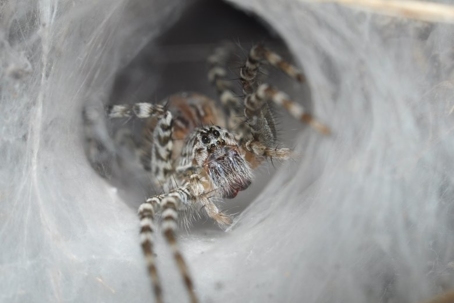Can Funnel Web Spiders Bite?
Yes, funnel-web spiders can bite people.
Do Funnel Web Spiders Bite?
Funnel-web spiders generally avoid humans and pets, but bites can occur in certain situations, particularly when the spider feels threatened or cornered. The likelihood of these spiders biting increases under the following circumstances:
Accidental Disturbance
Stepping on or near a spider’s burrow or hiding place (under logs, rocks, leaf litter, or in garden beds).
Reaching into dark spaces, sheds, or storage areas where the spider may be hiding.
Handling
Attempting to pick up, move, or trap the spider.
Children or pets poking at the spider out of curiosity.
Invasion of Homes
Funnel-webs occasionally wander indoors, particularly during wet or cold weather.
Pets, especially cats and dogs that explore dark corners or crawlspaces, may encounter them.
Defensive Behavior
If the spider feels trapped or threatened, it may raise its front legs and display aggression before biting.
Male Sydney funnel-web spiders are particularly prone to defensive biting, as their venom is more potent and they are more mobile while seeking mates.
Pet Encounters
Dogs sniffing under logs, digging in soil, or exploring crawlspaces may provoke a bite.
Cats may paw at or corner the spider, triggering a defensive strike.
Funnel-web spiders are not aggressive unless provoked. Most bites occur when a human or pet unknowingly disturbs the spider’s hiding spot or tries to handle it.
Funnel Web Spider Bites
Funnel-web spider bites, particularly from Sydney funnel-web spiders (Atrax robustus), are considered extremely serious medical emergencies:
Severity of the Bite
Venom potency: The venom contains neurotoxins (especially atracotoxins) that affect the nervous system.
Rapid symptom onset: Symptoms can develop within 15–30 minutes of a bite in severe cases, though milder reactions may take longer.
Potential outcomes: Without treatment, bites can lead to respiratory failure, cardiac complications, and death, especially in children. Adults can also be severely affected, but fatalities are rarer due to body size and availability of antivenom.
Local effects:
Pain at the bite site
Redness and swelling
Tingling or numbness
Systemic effects (can escalate quickly):
Profuse sweating
Muscle spasms and twitching
Nausea and vomiting
Increased salivation and tearing
Breathing difficulties
Elevated blood pressure or heart rate
Confusion or agitation in severe cases
Other Risks
Delayed treatment: The biggest risk is waiting too long to seek medical attention. Early administration of antivenom is highly effective.
Complications in children and pets: Children and smaller pets are at greater risk because the venom affects smaller bodies more severely.
Secondary injuries: Scratching or trying to remove the spider may worsen the bite site or introduce infection.
Misidentification: Treating a serious bite as a minor spider bite can delay life-saving care.
Immediate Actions
Call emergency services immediately.
Apply a pressure immobilization bandage to the bitten limb.
Keep the patient still and calm. Movement can spread venom faster.
Do not attempt to cut, suck, or wash the bite site.
A funnel-web bite—especially from a male Sydney funnel-web spider—can be life-threatening, and even with proper care, medical intervention should be immediate.
What Do Funnel Web Spider Bites Look Like?
Funnel-web spider bites can be subtle at first and often don’t immediately appear dramatic, which can make them easy to underestimate. Here’s what you need to know:
Immediate Appearance
Usually presents as two small puncture marks from the spider’s fangs.
The area may be red or slightly swollen, but sometimes the bite looks almost normal initially.
Pain at the site may be mild or moderate at first, then worsen over time.
Within Minutes to Hours
Redness can spread slightly, and swelling may increase.
Tingling, numbness, or a burning sensation may develop around the bite.
Some people report local sweating or warmth near the bite site.
Systemic Signs
Funnel-web venom affects the nervous system, so the bite site appearance alone is not enough to assess severity. Systemic symptoms may include:
Profuse sweating
Nausea and vomiting
Muscle spasms or twitching
Salivation or tearing
Breathing difficulty
The bite may look minor while the venom is already affecting the body. Any suspected funnel-web bite should be treated as an emergency, even if the bite site seems small. Pets may show less obvious bite marks but can quickly develop severe symptoms if bitten.
What To Do About Funnel Web Spider Bites
If you are bitten by a funnel-web spider, it is a medical emergency. Immediate and proper first aid can be life-saving:
Call Emergency Services Immediately
Dial 911 (or your local emergency number) right away.
Inform them it is a suspected funnel-web spider bite, which may require antivenom.
Apply a Pressure Immobilization Bandage
Do not wash the bite.
Firmly wrap the bite area with a bandage, starting just above the bite and covering the entire limb.
Immobilize the limb with a splint or sling if possible.
Keep pressure firm but not so tight that circulation is cut off.
This slows venom spread through the lymphatic system.
Keep the Patient Still and Calm
Movement accelerates venom spread, so keep yourself or the victim as still as possible.
Reassure children or pets to reduce panic.
Monitor Symptoms
Watch for signs of difficulty breathing, muscle spasms, sweating, nausea, or confusion.
Be prepared to perform CPR if the person stops breathing.
Avoid Dangerous Actions
Do not try to cut, suck, or wash the bite.
Do not apply a tourniquet; this can worsen tissue damage.
Do not apply ice; it does not neutralize venom and may reduce circulation to the area.
Transport Safely
If emergency services are delayed, transport the person with the limb immobilized and bandaged, keeping them calm and still.
Bring the spider (safely contained) if possible, for identification—this helps doctors administer the correct antivenom.
Even if the bite seems minor, funnel-web spider venom acts quickly, especially in children or pets, so every minute counts.

